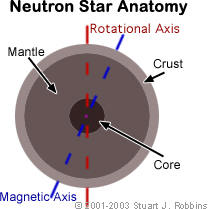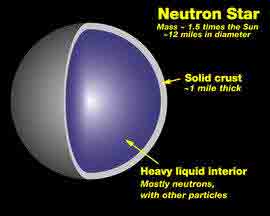|
       
> Star Formation
> Life and Death of a star
> Physical Description
> Star Catalogues
> Classification of Stellar Spectra
> Double Stars
> Variable Stars
> Neutron Star
> Black Holes
    
|
A neutron star is a
type of degenerate star composed mostly of densely packed neutrons,
generally about 25 km in diameter and as massive as an average star. Stars
that are more than about 8 times more massive at birth than the Sun
collapse into neutron stars when they go supernova. Neutron stars thus
represent a sort of middle ground between white dwarfs and
black holes.
Neutron stars were among the first major astronomical objects whose
existence was first predicted from theory (1933) and later (1967) found to
exist, at first as radio pulsars.
Anatomy of a Neutron Star
A neutron star is a star made entirely out of neutrons, as
the name suggests. These are the remains of stars that had between 1.4 and
9 times the mass of our Sun (solar masses). After a star goes nova, the
remaining core collapses while the outer layers are blasted off into space
to create a nebula. Gravity shrinks and condenses the core into a sphere
about the size of Manhattan (25 km (15 mile) diameter) within a few
seconds. A neutron
star is so dense that a pinhead's worth of material from one would weigh
as much as a supertanker. neutron
star is so dense that a pinhead's worth of material from one would weigh
as much as a supertanker.
Under ordinary circumstances that we Earthlings are comfortable with, this
could not be accomplished. Atoms are mostly empty space as a result of one
of the four fundamental forces: the Electro-Magnetic (EM) Force*. This
keeps the electrons out of the atom's nucleus. With the EM force being the
only thing that matters, the star would not be able to shrink to such a
size, simply because of the size and number of its atoms. However, because
of the star's mass, gravity (another of the four fundamental forces) is
able to overcome the EM force. Thus, in those brief seconds, the EM force
is broken and the electrons and protons combine into neutrons. All that is
left are the neutrons, and creates the immense density inherent in the
neutron star.
 |
|
Cross Section of a Neutron Star |
A neutron star's anatomy is very simple, and it has three main layers: a
solid core, a "liquid" mantle, and a thin, solid crust. Neutron stars also
have a very tiny (a few centimeters - about an inch) atmosphere, but this
is not very important in the functioning of the star. A neutron star also
has two axes: a magnetic one and an axis of rotation. Just as Earth's
magnetic axis does not run through the geographic poles, a neutron star's
axes rarely line up. (Please bear in mind that the schematic at the right
is not drawn to scale).
[Top]
Pulsars
A pulsar is the same thing as a neutron star, but with one
added feature. A pulsar emits two very high-energy beams into space,
concentrated along its magnetic axis (the magnetic field is around one
trillion (1,000,000,000,000) times that of the Earth's). The beams are
made of material usually stolen from a companion star, and the particles
are accelerated to speeds as great as 20% the speed of light.
Pulsars (and neutron stars) spin very rapidly , most at about once every
second (the record for the fastest is at 642 rotations per second, and the
record for the slowest is one spin every 4.308 seconds). The reason for
the rapidity in the spin is due to the law of conservation of angular
momentum. This law has such implications that if an object is spinning at
a certain speed, then is shrunk but keeps the same mass, it must increase
its rotation rate. For an example of this, take a ball attached to a
string and spin it around in such a way that the string wraps around your
hand or wrist. You will notice that as the ball comes in closer, it
rotates more quickly. Also, once it is wrapped, go the other way so that
it unwraps. You will notice that the ball goes more slowly as the string
is let out. Another practical example is to watch a figure skater - if
they want to spin quickly, they will draw their arms and leg in closer to
their body, and in order to slow down, they spread out.
Pulsars will eventually slow down and stop spinning, due to energy lost as
it sends off ripples in space (also called gravitational waves, that
emanate from all moving massive objects; the waves travel at the speed of
light). It will then be seen as an ordinary neutron star because if the
beams no longer sweep past Earth we can't see it "pulsing".
In some rare instances, two neutron stars will be locked in a binary star
relationship. Because of energy lost, they will slowly spiral in towards
each other, and merge. When they merge, they will almost always form a
black hole.
[Back] [Top] [Next] |
 neutron
star is so dense that a pinhead's worth of material from one would weigh
as much as a supertanker.
neutron
star is so dense that a pinhead's worth of material from one would weigh
as much as a supertanker.